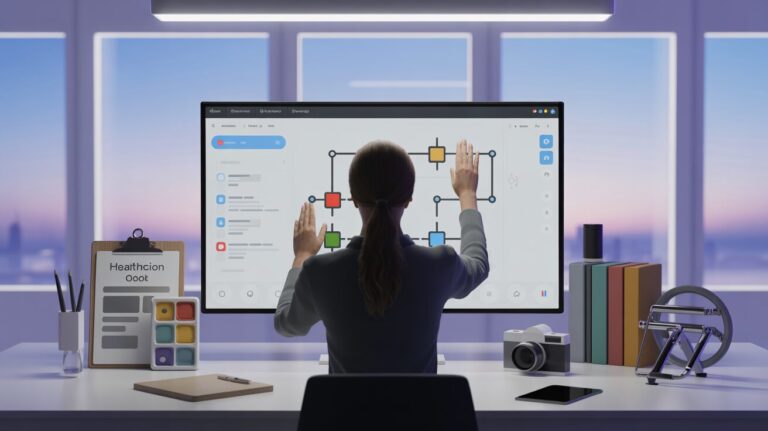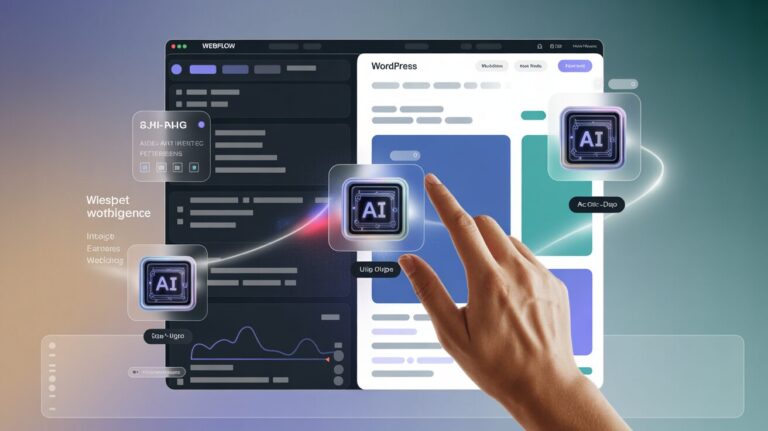Table Of Contents
Voice-powered AI applications are revolutionizing how we interact with technology. From smart speakers that control our homes to virtual assistants that schedule our meetings, voice interfaces have become an integral part of our digital experience. However, until recently, creating these sophisticated voice applications required extensive coding skills and AI expertise—placing them out of reach for most professionals, entrepreneurs, and content creators.
The good news? The landscape is changing rapidly. Today’s AI voice app platforms are making it increasingly possible for people without technical backgrounds to build powerful voice experiences. But with so many options available, how do you know which platform is right for your specific needs?
In this comprehensive guide, we’ll compare the top AI voice app platforms based on ease of use, functionality, customization options, and integration capabilities. Whether you’re a content creator looking to engage your audience in new ways, an educator developing interactive learning materials, or a business owner wanting to enhance customer service, this comparison will help you navigate the evolving world of voice AI development.
AI Voice App Platforms
Comparison Guide for Non-Technical Creators
Traditional Platforms
- Google Dialogflow: Requires moderate technical skills; offers advanced NLP
- Amazon Alexa Skills: Device-specific; requires JavaScript knowledge
- Voiceflow: Visual interface but needs conversation design expertise
- Rasa/Botpress: Open-source options requiring significant development resources
No-Code Alternatives
- Visual Interfaces: Drag-drop-link design eliminates coding requirements
- Pre-built Templates: Ready-made components that can be customized
- Natural Language: Platforms that understand plain instructions
- Built-in Guidance: Context-aware help for best practices
The Estha Advantage
Truly No-Code
Build sophisticated AI apps without any programming knowledge
Rapid Development
Create fully functional AI voice apps in just 5-10 minutes
Complete Ecosystem
Learn, build, launch, and monetize with integrated platform tools
Top Use Cases for Voice AI Apps
Education
Interactive learning assistants and study tools
Healthcare
Treatment plan guides and symptom assessment
Business
Customer service and appointment scheduling
Content Creation
Interactive experiences for audience engagement
Ready to Create Your Own AI Voice App?
No coding required. Build custom AI solutions in minutes with Estha’s intuitive platform.
Estha – Making AI Voice App Development Accessible to Everyone
Why Voice Applications Are Transforming Industries
Before diving into specific platforms, it’s important to understand why voice applications are gaining such momentum across industries. Voice interfaces offer several compelling advantages over traditional graphical user interfaces:
Natural Interaction: Humans naturally communicate through speech, making voice interfaces intuitive and accessible. This reduces the learning curve for new technologies and makes digital tools more inclusive for diverse user groups.
Hands-Free Operation: Voice apps enable users to interact with technology while their hands and eyes are occupied with other tasks—whether cooking, driving, or performing complex procedures in professional settings.
Increased Efficiency: Speaking is typically faster than typing, allowing for quicker information exchange. For many tasks, voice commands significantly reduce the time required to navigate menus or input data.
Accessibility: Voice applications break down barriers for users with visual impairments, limited mobility, or literacy challenges, making technology more accessible to everyone.
Personalization: Modern voice applications can recognize individual users, learn from interactions, and provide increasingly personalized experiences over time.
These benefits explain why industries from healthcare and education to retail and manufacturing are embracing voice technology. Now, let’s examine the platforms that make these applications possible.
Top AI Voice App Platforms Compared
The market offers several approaches to building voice applications, ranging from developer-focused frameworks to increasingly user-friendly no-code solutions. Here’s how the leading platforms compare:
Google Dialogflow
Overview: Google’s Dialogflow is a comprehensive natural language understanding platform that powers voice and text-based conversational experiences.
Key Features:
- Advanced natural language processing capabilities
- Pre-built agents for common use cases
- Integration with Google Assistant and other Google services
- Support for multiple languages
- Built-in analytics for conversation analysis
Ease of Use: Dialogflow offers a visual interface, but still requires some technical understanding. While simpler than raw programming, it has a moderate learning curve for complete beginners.
Limitations: Complex functionalities often require coding knowledge. The platform works best for those with at least some familiarity with conversation design concepts and basic programming principles.
Ideal For: Developers and technically-inclined professionals who need advanced NLP capabilities and Google ecosystem integration.
Amazon Alexa Skills Kit
Overview: The Alexa Skills Kit enables creators to build voice experiences (“skills”) for Amazon’s popular voice assistant ecosystem.
Key Features:
- Direct integration with the Alexa ecosystem
- Built-in monetization options
- Alexa Presentation Language for multimodal experiences
- Access to Amazon’s extensive voice recognition technology
- Templates for common skill types
Ease of Use: Amazon offers both code-based and visual builders. The Alexa Developer Console provides templates, but creating sophisticated skills typically requires JavaScript knowledge using AWS Lambda.
Limitations: The platform is specifically designed for Alexa devices, limiting cross-platform potential. Additionally, complex skills development still requires significant technical expertise.
Ideal For: Developers wanting to reach Alexa’s massive user base and companies looking to establish a presence on Amazon’s voice ecosystem.
Voiceflow
Overview: Voiceflow offers a visual platform for designing, prototyping, and building voice apps without extensive coding.
Key Features:
- Visual conversation design interface
- Drag-and-drop components
- Integration with Alexa and Google Assistant
- Collaborative team features
- Testing and analytics tools
Ease of Use: Voiceflow offers one of the more user-friendly approaches to voice app design, with its visual flowchart-based interface. However, understanding conversation design principles is still important for creating effective applications.
Limitations: While more accessible than pure coding approaches, advanced customization may still require technical knowledge. The platform is primarily focused on voice assistant integrations rather than standalone applications.
Ideal For: Designers and product managers who need to prototype and build voice experiences with minimal coding.
Botpress
Overview: Botpress is an open-source conversational AI platform that can be adapted for voice applications.
Key Features:
- Visual flow editor
- Natural language understanding capabilities
- Open-source core with enterprise options
- Extensible with custom modules
- Multi-channel deployment options
Ease of Use: Botpress offers a visual interface that simplifies bot creation, but its primary focus is on text-based chatbots. Adapting for voice requires additional configuration and potential coding.
Limitations: Not specifically designed for voice-first applications, meaning additional integration work is often necessary. The open-source nature means less hand-holding for beginners.
Ideal For: Organizations that need both chat and voice capabilities and have technical resources to customize the platform.
Rasa
Overview: Rasa is an open-source framework for building contextual AI assistants and chatbots that can be extended to voice applications.
Key Features:
- Highly customizable machine learning components
- Full control over conversation data
- On-premises deployment options
- Active open-source community
- Enterprise-grade security features
Ease of Use: Rasa requires programming knowledge and familiarity with machine learning concepts. It’s one of the more technical options on this list, requiring comfort with Python and command-line interfaces.
Limitations: Significant technical expertise is required. Rasa is not a no-code or low-code solution and demands substantial development resources.
Ideal For: Organizations with data science and development teams that require maximum customization and data privacy.
The No-Code Revolution in Voice AI
While the platforms above have made voice app development more accessible than it was five years ago, many still present significant barriers for non-technical creators. This is where the no-code revolution comes in—a movement to democratize technology creation by removing coding requirements entirely.
True no-code platforms focus on:
Visual Development: Intuitive interfaces that represent logic and flows visually rather than through code.
Templates and Pre-built Components: Ready-made elements that can be customized to specific needs without starting from scratch.
Natural Language Interfaces: Systems that allow creators to describe what they want in plain language rather than technical specifications.
Contextual Guidance: Built-in assistance that helps users understand best practices and avoid common pitfalls.
This approach is particularly important for voice applications, where the complexity of natural language processing has traditionally kept development out of reach for most professionals.
How Estha Changes the Game for Voice App Creation
Within this evolving landscape, Estha represents a significant leap forward in making AI voice applications accessible to everyone. While most platforms still require some technical understanding or specialized knowledge, Estha was built from the ground up with non-technical creators in mind.
Key Differentiators:
Truly No-Code Development: Estha’s drag-drop-link interface eliminates coding entirely, allowing anyone to create sophisticated AI applications without programming knowledge.
Rapid Development: Most AI voice apps can be created in just 5-10 minutes, dramatically reducing the time investment required compared to other platforms.
Personalized Brand Voice: Unlike many platforms that produce generic-sounding AI, Estha enables creators to infuse their unique expertise and brand voice into their applications.
Complete Ecosystem: Beyond just creation, Estha provides education (EsthaLEARN), scaling resources (EsthaLAUNCH), and monetization options (EsthaeSHARE), addressing the full lifecycle of AI application development and deployment.
Industry Versatility: Whether you’re in education, healthcare, content creation, or running a small business, Estha’s flexible platform adapts to industry-specific needs without requiring specialized versions.
This approach represents a fundamental shift from other platforms that may offer visual interfaces but still assume some level of technical knowledge or conversation design expertise.
Real-World Use Cases for AI Voice Applications
The practical applications of voice AI span virtually every industry. Here are some compelling use cases that demonstrate why voice applications are worth exploring:
Education: Interactive voice-based learning assistants that help students practice language skills, answer questions about course material, or guide them through complex concepts at their own pace.
Healthcare: Voice applications that help patients follow treatment plans, remind them to take medications, or provide preliminary symptom assessment before medical appointments.
Content Creation: Voice-driven tools that help creators repurpose their expertise into interactive experiences, allowing audiences to engage with their content through conversation rather than passive consumption.
Small Business: Custom voice assistants that handle appointment scheduling, answer frequently asked questions, or guide customers through product selection, freeing up staff for more complex interactions.
Personal Productivity: Voice applications that help individuals manage tasks, retrieve information from personal knowledge bases, or maintain habits and routines.
What makes these applications truly valuable is their ability to scale personal expertise. A single educator, healthcare provider, or business owner can create a voice application that shares their knowledge with thousands of users simultaneously—something that would be impossible through one-on-one interactions alone.
Future Trends in Voice AI Development
As we look ahead, several trends are shaping the future of voice AI development:
Multimodal Experiences: Voice apps are increasingly combining audio interfaces with visual elements, creating richer interactions that leverage multiple senses.
Personalization: Next-generation voice applications will adapt not just to user preferences but to emotional states, speaking styles, and contextual factors.
Edge Computing: More voice processing will happen directly on devices rather than in the cloud, improving privacy and reducing latency.
Specialized Domains: Rather than general-purpose assistants, we’ll see more voice applications with deep expertise in specific fields like medicine, law, or specialized hobbies.
Creator Economies: Platforms that allow experts to monetize their knowledge through voice applications will create new revenue streams for content creators and professionals.
The most significant trend, however, is democratization. As platforms like Estha continue to lower technical barriers, we’ll see an explosion of voice applications created by domain experts rather than programmers—fundamentally changing who gets to shape the future of AI.
Conclusion
The landscape of AI voice application development is rapidly evolving, with options ranging from developer-focused frameworks to increasingly accessible no-code platforms. While traditional options like Google Dialogflow and Amazon Alexa Skills Kit offer powerful capabilities, they still require technical expertise that can be a barrier for many potential creators.
The emergence of true no-code platforms like Estha represents a significant shift in who can create sophisticated AI applications. By eliminating technical barriers and dramatically reducing development time, these platforms are enabling educators, healthcare providers, content creators, and business owners to bring their expertise to life through voice applications without depending on development teams.
As you consider which platform is right for your voice application needs, consider not just the technical capabilities but also the time investment required, the level of customization possible, and how well the platform aligns with your existing skills. The best platform isn’t necessarily the one with the most features—it’s the one that enables you to bring your unique vision to life most effectively.
The future of voice AI belongs not just to developers but to domain experts across all fields who can now directly shape how their knowledge is shared and experienced. This democratization of AI creation promises a richer, more diverse ecosystem of voice applications that truly reflect the breadth of human expertise.
Ready to Create Your Own AI Voice Application?
No coding or prompting knowledge required. Build your custom AI solution in minutes with Estha’s intuitive drag-drop-link interface.



